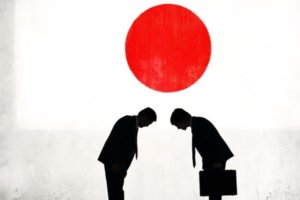Everyone knows that the customer is king. But it is pushed to extremes in Japan – the customer is not king, but God. Hospitality is an essential value, you must satisfy people’s needs and avoid offending them. When entering a store, every employee shouts, ‘irasshaimase!’ (which can be translated as ‘welcome’) and bows a little. Hierarchy is omnipresent in the Japanese society, in all kinds of relationships (a senpai should be respected by his/her kouhai, the eldest child by his siblings, a teacher by his/her students, etc.).
But in business, not showing respect or not giving of your best to your customers – or at least not pretending to – is lethal for your company. As we saw, building customer trust is essential, and to do so you must follow the Japanese etiquette and standards. Why would customers choose a company who does not treat them as well as most of the other companies? Competition is stiff, so you must follow the rules and do as much or even better than other companies. If not, customers will take their business elsewhere.
How Customer Service Is in Japan

Let’s see how the service is when not digital. First, in many stores, it is not strange to see the sellers packing your purchase, then carrying it until the exit before holding it out to you, with both hands and a bow. Not every store (or hostel, etc.) keeps doing it, especially when it is crowded, but it is still a thing in Japan. Employees want customers to have the best experience possible, even in filling stations: one gas up, another clean your windshield and another wipe it. Then, they bow until you leave.
When we know how people are treated when shopping, it is not surprising that their expectations are high – even online. According to James Hollow, 3 key ingredients are often met in Japan:
- A ‘rigorous training regime based on high standards’
- ‘Staff with pride in their work’
- Staff who ‘know their company/product really well’
In Japan, serving others has a more positive connotation than in the West, people want to be part of a community by helping others (this is also why many seniors keep working after the retirement age). Japanese people are also looking for a certain form of perfection, they are afraid of failure and mistakes. They strive for perfection and want to provide the best customer experience. It is also why convenience stores or vending machines are so widespread in Japan: convenient, quick, easy to use. Totally Japanese. Concerning employees themselves, even if they do not succeed, efforts are rewarded: it is the ‘ganbarism’ (from ganbaru, to persevere). Sometimes, employees do their best, spend hours and hours on a project even though they knew right at the beginning that the project was not feasible, in order to demonstrate ganbarism. It is a question of respect for the customers, but also a way to show that they are part of the community. Also, customers do not often openly complain, but when they do, the employees do not have much power to help them (like giving a discount, refund completely or partly, etc.).
How Your Customer Service Should Be

If you want to do business in Japan, you will have to take on board this sense of hospitality. But first of all, you must provide customer service in Japanese – in a perfect Japanese. Because the language is changing really fast with multiple variations, it is better to hire a native Japanese speaker or ask a specialized company.
Your team should also be fast and reply to everyone. In doing so, you will build a relationship with your customers. Even on your social media: reply to every inquiry when it is possible. Work on your communication, human contact is important when conducting business! Check out our articles about digital marketing in Japan and Japan’s most popular social media to know more about your target and adapt your strategy.

In addition to that, even if it seems to be a good idea to create a billing inquiry section, sometimes the customers need more information, have to go through multiple contacts or to do a lot of research on web self-service channels. Try to make your website as convenient and easy to use, with several options to contact assistance. If they purchased one of your products, wants to return it or are not satisfied, if they do not find how to contact you, they will give up and remember this bad experience. Understand how customers behave and what they would like to see: put yourself in their shoes!
Finally, it is important to attract customers, but it is even more important to keep them. Think about point cards with appealing benefits (not a small discount every 30,000JPY!). In 2007, Japanese had an average of 8,5 point cards and 5,3 digital cards. Some point cards, like the T-card by Tsutaya, enable people to collect points in many different stores. Some, like the Rakuten card, are also credit cards.
Reference soranews24.com/2016/10/06/5-things-about-japanese-customer-service-that-surprise-foreign-visitors/ soranews24.com/2017/06/19/why-is-japanese-customer-service-so-amazing-because-in-japan-its-one-strike-and-youre-out/ jameshollow.com/blog/good-japanese-customer-service-bad-can-get/ voyapon.com/customer-service-japan/ zerosix.com/blog/fidelisation/japon-la-fidelite-au-coeur-de-la-relation-client www.bcg.com/publications/2017/four-ways-improve-digital-customer-service.aspx

















